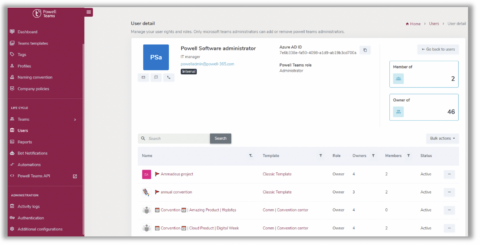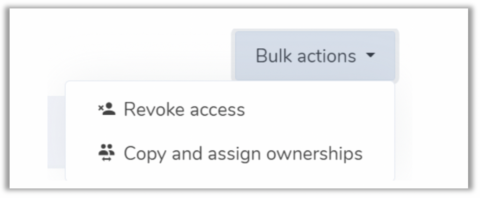Importance of Managing Users
Governance of Microsoft Teams is a critical aspect for organizations. By establishing governance, organizations can ensure that Teams is used consistently and effectively across teams, departments, and the entire organization. When we talk about governance, it implies having in place policies to manage tags, naming conventions, team privacy, and expired or unused teams.
However, governance goes beyond just managing the Teams space. To effectively govern Teams, organizations must also prioritize user management as an integral component of their governance strategy. User management encompasses tasks such as managing non-compliant users, guests, and users who are owners or members of too many teams or unused teams. Without proper attention and governance applied to user management, the overall management and security of Microsoft Teams will be hindered.
At Powell Software, we understand that effective governance of Teams extends beyond simply managing teams. It involves comprehensive management of users, ensuring that their experiences within Microsoft Teams are secure and seamless. Our focus is on providing a complete experience, which includes full visibility into the tenant’s users and their actions within the platform. Our aim is to simplify user management and promote good governance to ensure a secure and efficient environment for our customers.
What happens if you don’t manage users?
- Access to restricted information: If guest users are not properly managed, they may have access to information they should not have access to anymore. This includes internal files and documents, potentially leading to a data security breach.
- Overburdened owners: When a user is the owner of too many teams, they become overwhelmed with too much responsibility. The owner of a team is responsible for adding and removing members, and guests, changing team settings, and handling administrative tasks. As a result, the management of these teams becomes ineffective, and the owner may be unable to keep up with the demands of their role.
- Information overload: If a user is a member of too many teams, they can become overwhelmed with too much information and have difficulty keeping up with what is happening. This can lead to decreased productivity and ineffective collaboration.
- Lack of adoption: If a user is in very few teams (1 or 0), it may be a sign of an adoption issue. They may need to be trained on using Teams effectively or may not even have an Office 365 license. In either case, it can lead to decreased productivity and inefficiencies in collaboration.
What is Powell Governance User Management?

To prevent the negative consequences that can arise from not managing users properly,
Powell Governance introduces a cutting-edge feature known as User Management. This feature offers a novel approach to addressing issues by focusing on individual users rather than just teams.
With the User Management page on the Powell Governance administration center, administrators have a one-stop shop for all their user-related tasks. They can access a centralized list of all the users in their Microsoft Teams environment and view their relevant information, such as their roles, the teams they belong to, and the teams they own. This level of visibility allows administrators to completely understand the users within their environment, making it easier to monitor and manage.
The User Management page provides a comprehensive view of all the users in the Microsoft Teams environment and offers advanced filtering options for easy navigation. With the ability to sort users based on the number of teams they belong to or own, administrators can quickly identify any potential issues and take appropriate action.

Upon clicking on a user’s detail, administrators have access to additional information such as the user’s name, job title, email address, user status, Azure AD ID, Powell Governance’s role, and the number of teams they are a member or owner of. Additionally, administrators have the ability to modify a user’s Powell Governance role or add/remove them as a Powell Governance administrator.

One of the most critical aspects of the User Management page is its ability to perform actions on each user. This functionality is designed to help administrators manage various scenarios, such as guest management, onboarding, and offboarding. These actions are an essential part of the governance process and can be performed easily and quickly through the User Management page.

Administrators can manage a user’s team ownership or membership, granting or revoking access as necessary. This feature is especially useful during the onboarding process, where new employees need to be added to various teams, or during the offboarding process, where former employees need to be removed from teams to which they no longer need access.
Conclusion
Managing users within a Microsoft Teams environment is crucial to ensuring security and efficiency for the organization and its employees. Powell Governance User Management page offers a comprehensive solution for user management by providing administrators with complete visibility into users, their actions, and relevant information. This feature provides an easy-to-use platform for administrators to manage team ownership or membership and grant or revoke user access that, simplifies guest management, onboarding, and offboarding processes.
Read our next article, which delves more deeply into the User Management capabilities and presents various use case scenarios for you to benefit from. This article will offer valuable insights on optimizing your use of the User Management feature, from simplifying the user management process to enhancing security measures. To start exploring the full potential of User Management, click the link to access the article.




